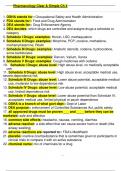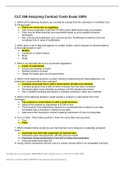Pharmacology Clear & Simple Ch 4
1. OSHA stands for:: Occupational Safety and Health Administration
2. FDA stands for:: Food and Drug Administration
3. DEA stands for:: Drug Enforcement Agency
4. DEA decides: which drugs are controlled and assigns drugs a schedule or
category
5. Schedule I Drugs: examples: Heroin, LSD, methaqualone
6. Schedule II Drugs: examples: Morphine, PCP, cocaine, methadone,
methamphetamine, Ritalin
7. Schedule III Drugs: examples: Anabolic steroids, codeine, hydrocodone,
some barbiturates
8. Schedule IV Drugs: examples: Darvon, Valium, Xanax
9. Schedule V Drugs: examples: Cough medicines with codeine
10. Schedule I Drugs: abuse level: High abuse level, no medically acceptable
use
11. Schedule II Drugs: abuse level: High abuse level, acceptable medical use,
severe dependence risk
12. Schedule III Drugs: abuse level: Lower abuse potential, acceptable medical
use, moderate to low dependence risk
13. Schedule IV Drugs: abuse level: Low abuse potential, acceptable medical
use, limited dependence risk
14. Schedule V Drugs: abuse level: Lower abuse potential than Schedule IV,
acceptable medical use, limited physical or psych dependence
15. OSHA is a branch of what govt dept:: Dept of Labor
16. DEA purpose:: enforcement of Controlled Substances Act, public safety
17. all approved drugs must be proven ___ and ____ before they can be
marketed: safe and effective
18. common side effects: headache, nausea, vomiting, diarrhea
19. adverse reaction: a side effect that can cause severe harm or death (like
airway swelling)
20. adverse reactions are reported to:: FDA's MedWatch
21. placebo: inactive (inert)substance that is sometimes given to participants in
clinical trials to compare it with an active substance
22. chemical name: mix of chemicals for a drug
1/4





